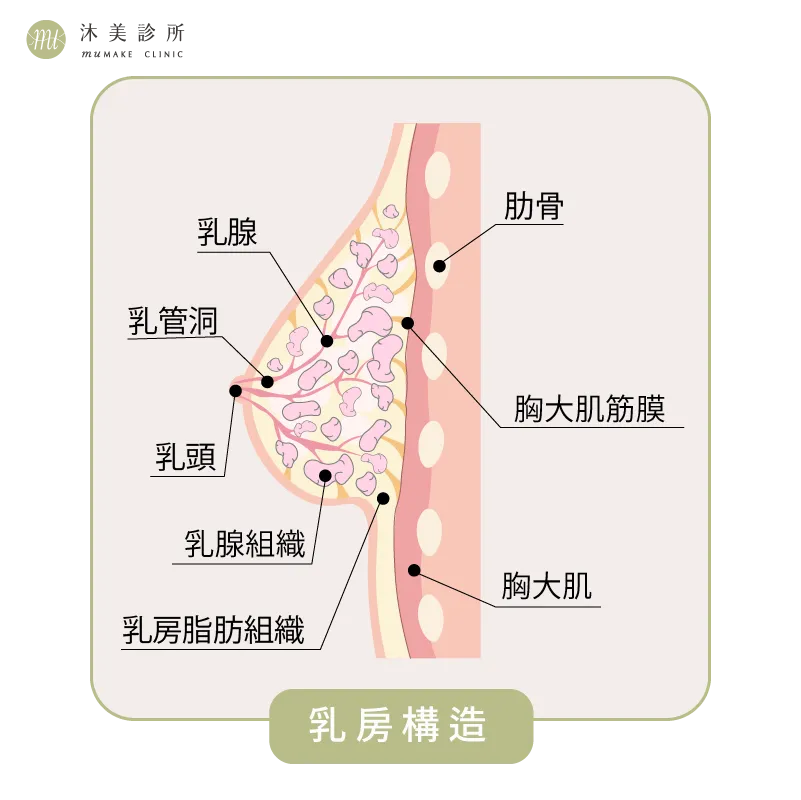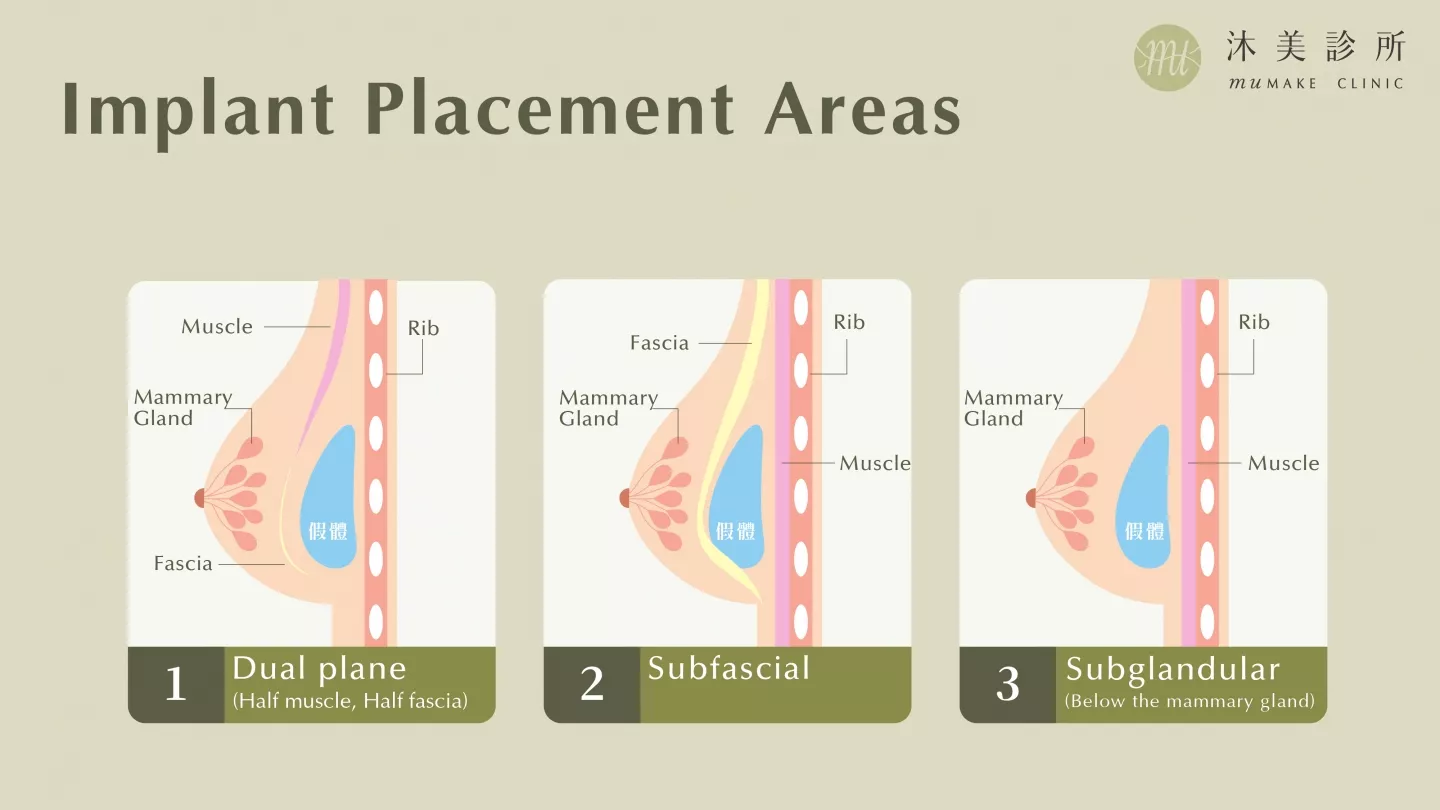For many people, mammoplasty is a must-do item on their lifetime to-do list. Apart from enhancing beauty, it also boosts confidence. However, achieving a pair of perfectly satisfying breasts is not just about increasing their size; it's also about ensuring that the breasts have a soft and natural feel, with natural movement effects when standing or lying down.
To achieve these goals, besides choosing the most suitable implant material for oneself, the "selection of breast implant placement" is a crucial factor affecting the realism of mammoplasty!
Today, from the perspective of MuMake Clinic, we have invited Dr. Chen Chenkun, a highly reputable authority in the field of mammoplasty, to answer the question of how to choose the placement position for breast implants. How to decide the level of implant placement? Let's find out together!
Creating a Naturally Beautiful Bust: Understanding Breast Structure
We often hear successful cases of mammoplasty claiming that their breasts look as if they were born that way. With advancements in medical technology, breast implants are continuously evolving. In fact, according to statistics from the International Society of Aesthetic Plastic Surgery (ISAPS), "mammoplasty" has become the top cosmetic surgery worldwide, and the age range of mammoplasty patients is decreasing year by year.
Taiwan is no exception, with a high acceptance rate for mammoplasty. Dr. Chen Chenkun, a plastic surgeon with nearly 20 years of experience in the field, states that the number of mammoplasty patients is increasing every year. As a professional plastic surgeon, it is essential to provide correct information to dispel opaque and incorrect medical information.
Mammoplasty is a complex and precise procedure that requires experienced and highly skilled surgeons. It's definitely not just about making an incision and inserting implants into the breasts! Where the implants should be placed, how they should be placed, and where the incisions should be designed... every decision will determine the outcome of the surgery. Therefore, it is essential to have thorough discussions with a professional plastic surgeon before the procedure.

Understanding Breast Structure

Through the cross-sectional diagram of breast structure above, we can see that the breast structure can be roughly divided into several layers, from outermost to innermost: breast skin → subcutaneous fat → glandular tissue → fascia of pectoralis major muscle → pectoralis major muscle → pectoralis minor muscle → ribs.
As implants need to be placed within the layers of breast structure, we can understand why the position and depth of implants will affect the softness of the breasts after mammoplasty, as well as the shape, fullness, and aesthetics of the breasts. Therefore, the choice of "implant placement depth" is closely related to the "texture and appearance" presented after the surgery.
What are the mammoplasty positions? Analysis of common implant placement levels
With a concept of breast structure in mind, we can now explain the classification of implant placement positions! For East Asian individuals, common mammoplasty placement positions include "subglandular," "dual-plane," and "subfascial."

Dual Plane

What is "dual-plane mammoplasty"? This method of implant placement is currently the most favored among East Asian individuals. Because most East Asians lack upper chest muscle, this placement has a benefit: it allows the upper half of the prosthesis to be covered by the pectoralis major muscle, while the lower half is positioned beneath the fascial layer, creating a "dual-plane mammoplasty" (also known as: dual-plane composite mammoplasty).
By placing the implants simultaneously beneath the fascia and the pectoralis major muscle, the pectoralis major muscle can increase the thickness of the skin tissue visually near the upper breast hemisphere and cleavage area, creating a fuller, more substantial-looking mammoplasty effect. Not only the upper chest but also the cleavage can be completely enveloped by soft tissue, resulting in a more full and concentrated cleavage effect. Additionally, since the lower half of the breast (the lower hemisphere) is not covered by muscle, it reduces the unnatural bouncing of implants under muscle movement, resulting in a more natural appearance visually and a more realistic and soft touch sensation.
However, "dual-plane mammoplasty" is the most challenging in terms of the mammoplasty layers and requires the highest level of skill from plastic surgeons. Novice plastic surgeons may find it difficult to design beautiful breast shapes and lines in this layer, so it is better to seek experienced plastic surgeons specializing in this field.
Subfascial

"The fascia" is an extremely thin connective tissue layer, only 1-2mm thick, that covers the pectoralis major muscle. Because the fascial layer has fewer nerve and blood vessel distributions, the placement method of "subfascial mammoplasty" is the least painful among all implant placements. Additionally, it allows for the control of bleeding to a minimum range, resulting in relatively mild postoperative pain.
Furthermore, due to the shallower depth of the subfascial layer, subfascial mammoplasty can present a naturally full and easily protruding cleavage, with a lower risk of postoperative infection and capsular contracture compared to subglandular mammoplasty.
However, because the subfascial layer is relatively shallow, the space is smaller compared to the dual-plane layer. Therefore, this placement position is not suitable for clients requiring larger cc implants or for individuals with less than 1 cm thick breast fat tissue or prominent pectus excavatum.
Subglandular

"Subglandular mammoplasty" refers to placing implants between the "breast gland" and the "pectoralis major muscle." Since there is no need to detach the fascia and pectoralis major muscle, it is relatively easier to shape a firm and full breast, and it can easily create cleavage.
However, because the upper tissue in the subglandular position is thin, it is generally not suitable for the body structure of East Asians, especially for those with a slender body type and minimal breast fat. Not only is there a risk of the implant edges being visible, but the sensation of feeling the implant is also more noticeable.
Finally, the safety of subglandular mammoplasty is also a concern for professional plastic surgeons. Both the infection rate and capsular contracture rate are relatively high, which is why we generally do not recommend this placement position.
How to Choose the Right Mammoplasty Placement? Which One is Suitable for Me?
With so many options for mammoplasty placement, which one should you choose?
In general, plastic surgeons consider three factors:
- Natural chest shape and condition of each individual
- Thickness of skin tissue
- Lifestyle and exercise habits
Through comprehensive assessment, the most suitable implant depth and placement level can be determined for each mammoplasty patient. This helps achieve natural and beautiful postoperative breast shape, minimizing the occurrence of post-augmentation sequelae.
Therefore, to confirm the appropriate implant position for yourself, it is best to discuss directly with a professional plastic surgeon. Mu Mei Clinic offers a complete mammoplasty simulation process to assist patients and surgeons in determining the surgical details.
Before making a decision, you are also welcome to refer to our self-made comparison table, which helps you better understand the characteristics and pros and cons of different mammoplasty placement positions.

After reading the above summary, I believe everyone should have a better understanding of the placement of breast implants. If you have any further questions, feel free to join MuMskr Clinic's official LINE. We will personally answer your questions!
Finally, Dr. Chen Chenkun would like to remind everyone that mammoplasty is an extremely delicate and customized plastic surgery procedure. It is strongly recommended to seek experienced professionals and reputable clinics, communicate thoroughly before surgery, and follow postoperative instructions diligently. This way, you can achieve the most satisfying and beautiful breast shape, boosting your confidence and posture!





 Booking Now
Booking Now  Messenger
Messenger  LINE
LINE 


